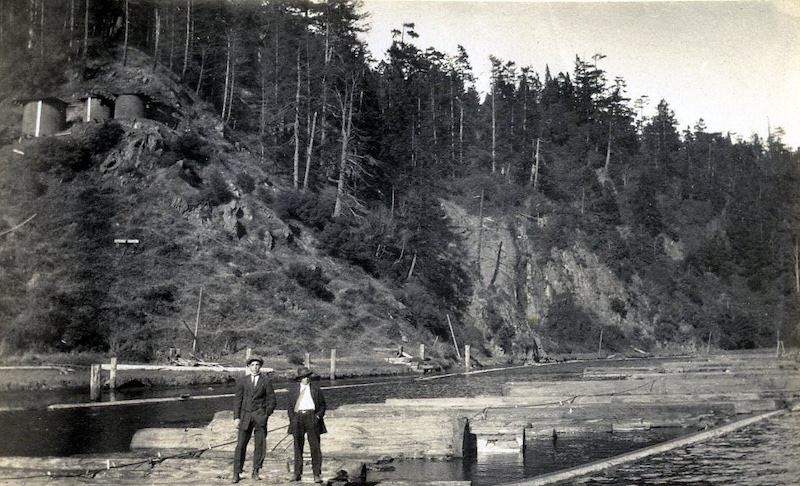For decades, log rafts were a vital part of transporting timber down Big River to the Mendocino Mill. Francis Jackson’s book, “Big River Was Dammed,” offers a fascinating glimpse into this process, detailing the challenges of controlling logs as they made their way toward the mill pond.

Philip Madera and Joe Vincent standing on a log raft in the Mendocino Mill Pond on the north side of Big River, 1913. On the hill above them are large water tanks, filled by gravity from a year-round creek, which the Mendocino Lumber Company maintained in case of a fire.
Logs cut in the forest were floated downstream to the Boom, where they were carefully bundled into rafts. Without rafts, the logs could have easily drifted out of control with the tides, making the task of retrieving them both difficult and dangerous.
In the early days, the rafting process relied entirely on manpower. Logs were secured together using wooden pegs and manila ropes, then guided downriver by men standing atop them with long poles. This job was not for the faint of heart—it took balance, strength, and no small amount of courage. Eventually, rowboats were introduced to assist with the process, allowing men to steer from a safer vantage point. Joshua Grindle and his partner J. L. Clark “oared a double-ender boat,” and on their return trip upriver for another raft, would transport passengers or freight for a fee.
Everything changed in 1902 with the introduction of the Maru, a flat-bottomed scow equipped with a steam-powered paddle wheel. Unlike oxen pulling logs along the ground, the Maru didn’t drag the rafts but simply kept a strain on the connecting rope to keep the raft within the river channel.
All log rafts were brought down the river on an outgoing tide. Many of these trips were made at night, with only moonlight (if they were lucky) to guide the way. It must have been eerie to drift down a dark river, listening to the creak of logs and the steady churn of the paddle wheel, relying on instinct and experience to avoid running aground.
Once the Maru reached the mill pond, the raft was released into the storage area where a swing gate helped trap it inside. Here, the logs floated freely, waiting to be processed into lumber. The whole system was a perfect blend of natural forces, ingenuity, and sheer grit—one more example of how early Mendocino pioneers found clever ways to work with the landscape to get the job done.
On Saturday, March 15, please join the Kelley House Museum and the Noyo Center for Marine Science for a special panel discussion with some of the original Mendocino Whale War members: Heidi Cusick Dickerson, Barry Cusick, Sally Welty, and Lee Welty. Also participating will be Shana Hadley, J.D. Mayhew’s granddaughter, and Katherina Audley from the Noyo Center, who will speak about the state of whaling today and whale population recovery. 4:00pm–5:30pm, $7 members, $10 general public. The Kelley House will have a small exhibit about the Whale War during March. Three framed J.D. Mayhew prints will be featured, on loan from the Prentice Gallery, and Mayhew whale cards and his Map of Mendocino will be for sale.